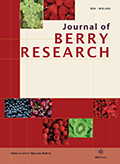Authors: Khayyat, Mehdi | Barati, Zahra | Aminifard, Mohammad Hossein | Samadzadeh, Alireza
Article Type:
Research Article
Abstract:
BACKGROUND: Barberry fruit is an important source of anthocyanin, and strongly uses for Zereshk Poloee, a delicious diet in Iran. OBJECTIVE: We are trying to find how fruit quality of barberry is affected under different locations and if sooner harvesting may be possible, which encouraged us to do these studies. METHODS: The present study was conducted in three different locations (Marvak, Marak and Amirabad with 2079, 1648 and 1480 m altitude) around Birjand, Iran. Fruit sampling was done 66, 98, 122, 155 days after full bloom (DAFB) and also in economical harvesting (EH) date. RESULTS:
…The results showed that berry number, fruit fresh weight (FW) and dry weight (DW), juice weight and volume, pH, total acidity (TA), total soluble solids (TSS), maturity index, anthocyanin and total phenols significantly changed with advancement of growing season under different climatic conditions. Interactive effect of sampling time×location indicated the highest pH in Marak and Amirabad and the highest TSS and TSS/TA ratio in Amirabad in EH, and the highest phenols in Marak in 155 DAFB and EH. The highest anthocyanin content accumulated in Marvak, exactly in EH. Using changes in FW, DW and volume of fruit, a double-sigmoidal curve observed for barberry fruit growth. CONCLUSION: Regarding to obtained data and specially anthocyanin accumulation, we propose regions with higher altitude for seedless barberry cultivation and production because of earlier harvest with more qualified fruit.
Show more
Keywords: Berberis vulgaris, altitude, anthocyanin, full bloom, fruit growth curves
DOI: 10.3233/JBR-170166
Citation: Journal of Berry Research,
vol. 8, no. 1, pp. 25-40, 2018





